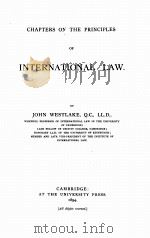《PRINCIPLES OF INTERNATIONAL INSOLVENCF》
| 作者 | PHILIP R WOOD 编者 |
|---|---|
| 出版 | LONDON SWEET & MAXWELL |
| 参考页数 | 1064 |
| 出版时间 | 1995(求助前请核对) 目录预览 |
| ISBN号 | 1847032109 — 求助条款 |
| PDF编号 | 813695628(仅供预览,未存储实际文件) |
| 求助格式 | 扫描PDF(若分多册发行,每次仅能受理1册) |

Part 1:General3
1Introduction3
General3
Policies of insolvency law4
Protection of creditors or debtors4
Summary of policies6
Debtors and creditors6
Effects of insolvency on legal systems8
Causes of bankruptcy9
Harmonisation of insolvency law10
Historical background11
Introduction11
Statistics12
The beginnings13
Insolvency in Western Europe from 110014
The triple polarisation19
Short history of rehabilitations21
Other recent developments27
Bank insolvencies28
State insolvency28
International insolvencies29
Conclusions30
2Comparison of work-outs,judicial rescues and liquidations31
Comparison of methods31
Three methods of dealing with an insolvency31
Overlaps31
Advantages and disadvantages of work-outs33
Final liquidation compared to work-outs34
Judicial reorganisations compared to private work-outs:general35
Advantages of judicial reorganisations36
Disadvantages of judicial reorganisations38
Other factors influencing the choice40
Jurisdictional attitudes to work-outs and judicial rescues41
Grading of reorganisation laws43
Classification of composition and rescue laws43
Modern corporate reorganisation proceedings44
Classification of modern reorganisations by country45
Policy factors and judicial reorganisations47
Main policy factors47
Use of judicial reorganisations48
Conclusion49
Part 2:Jurisdictions of the world53
3Legal families of the world53
Jurisdictions of the world53
What is a jurisdiction?53
Excluded "jurisdictions"53
Legal families of the world's jurisdictions55
The three main groups55
Transmission of legal systems55
Statistics of legal groups57
Conclusion57
American common law jurisdictions58
List of jurisdictions58
International presence58
Population and economics of the American common law group58
Legal origins of the American common law group59
Key insolvency law indicators of the American common law group59
Conclusion59
English common law jurisdictions59
List of jurisdictions59
International presence of the English common law group60
Population and economics of the English common law group61
Legal origins of the English common law group61
Key insolvency law indicators of the English common law group61
Conclusion62
Napoleonic jurisdictions62
List of jurisdictions62
Sub-groups of Napoleonic jurisdictions63
International presence of the Napoleonic group64
Population and economics of the Napoleonic group65
Legal origins of the Napoleonic group65
Key insolvency law indicators in the Napoleonic group66
Conclusion66
Roman-Germanic jurisdictions67
List of jurisdictions67
Sub-groups of Roman-Germanic jurisdictions67
International presence of the Roman-Germanic group68
Population and economics of the Roman-Germanic group68
Legal origins of the Roman-Germanic group68
Key insolvency law indicators in the Roman-Germanic group69
Conclusion70
Mixed civil/common law jurisdictions70
List of jurisdictions70
Conclusion71
Islamic jurisdictions72
List of jurisdictions72
Conclusion72
New jurisdictions73
Central Asian Republics and Macedonia73
Bhutan,Cambodia,Laos,Nepal73
Mongolia and Vietnam74
Conclusion74
Unallocated jurisdictions74
4Indicators of insolvency law75
Five key indicators75
Features of the five indicators75
The five key indicators75
Other key indicators of insolvency law78
Criteria for indicators78
Excluded or non-useful criteria78
Other key insolvency law criteria81
Regulatory law82
Insolvency-related corporate law criteria83
Litigation84
Costs and taxation85
Comparative methodology85
Classification of legal systems using the indicators87
Triple polarisation87
Comparison of jurisdictions on the criteria88
Conclusion89
5Anglo-American common law jurisdictions90
Introduction90
American common law jurisdictions90
Identity of jurisdictions90
Outlying jurisdictions90
Summary of US Bankruptcy Code91
English common law jurisdictions97
Identity of English common law jurisdictions97
Common characteristics of English common law jurisdictions97
British Overseas Territories100
Traditional English jurisdictions102
Hybrid English-based jurisdictions105
Country summaries of English common law jurisdictions106
Australia106
Canada109
England114
India116
Ireland117
lsrael118
New Zealand119
Singapore120
6Napoleonic jurisdictions121
General121
Identity of jurisdictions121
Common characteristics of traditional Napoleonic jurisdictions121
Sub-groups of Napoleonic jurisdictions123
Sub-group based on France123
Sub-group of European Napoleonic jurisdictions123
Latin American Napoleonic jurisdictions and the Philippines124
Other traditional Napoleonic jurisdictions126
Pre-Napoleonic jurisdictions127
Sharia Napoleonic127
Country summaries of Napoleonic jurisdictions128
Belgium128
Brazil129
Bulgaria132
France134
Greece135
Italy136
Mexico141
Portugal143
Romania143
Spain145
7Roman-Germanic jurisdictions146
General146
Identity of jurisdictions146
Traditional Roman-Germanic sub-group146
New Roman-Germanic group147
Country summaries of Roman-Germanic jurisdictions148
Austria148
Czech Republic149
Denmark149
Estonia151
Finland151
Germany151
Hungary153
Korea154
Latvia156
Lithuania156
Netherlands157
Norway157
Poland159
Russia159
Slovakia165
Slovenia167
Sweden167
Switzerland168
Thailand168
Turkey169
8Other groups of jurisdictions171
Mixed civil/common law jurisdictions171
Identity of jurisdictions171
Channel Islands171
China171
Japan179
Liechtenstein185
Malta185
Panama185
Quebec186
Scotland186
Southern African sub-group186
Taiwan188
Islamic jurisdictions189
New jurisdictions190
Unallocated jurisdictions194
Part 3:Insolvency topics197
9Entry criteria for insolvency:stays on claimant197
Entry criteria for insolvency proceedings197
Summary of entry criteria197
Proof of insolvency198
Liquidations and rescues199
Eligible petitioners199
Debtor incentives to commence proceedings201
Country examples of entry criteria201
Anglo-American common law jurisdictions201
Napoleonic jurisdictions204
Roman-Germanic jurisdictions208
Other jurisdictions212
Stays on creditors generally213
Summary list213
Stay on creditor attachments214
Stay on legal proceedings215
Disposals by the debtor of its assets216
Payments during a reorganisation proceeding218
10Management of insolvency proceedings219
Summary219
Summary list of potential managers219
Summary comment on the list219
Creditors219
Shareholders220
Debtor's existing management220
Courts221
Government officials222
Regulators223
Other issues223
Conclusion224
Jurisdiction examples224
Anglo-American common law jurisdictions225
Napoleonic jurisdictions229
Roman-Germanic and related jurisdictions231
11The bankruptcy ladder of priorities237
Introduction237
General237
Summary of the ladder237
Liquidations and rescue priorities238
De facto reversal of legal priorities238
Spacing of the rungs in the ladder239
Impact of priorities on cross-border insolvencies239
Super-priority creditors240
Summary list240
Secured creditors240
Title finance creditors242
Set-off credit243
Beneficiaries under trusts244
Owners wrongfully deprived of their property244
Creditors with direct action against third parties245
Creditors with rights of rescission249
Others249
Priority creditors249
Post-commencement administrative claims250
Taxes250
Employee remuneration and benefits250
Others251
Priority creditors and secured creditors252
General252
Anglo-American common law jurisdictions253
Napoleonic jurisdictions255
Roman-Germanic jurisdictions259
Other jurisdictions263
Subrogation to priority claims265
Pari passu creditors266
General266
Discounting266
Assignments for less than full value267
Subordinated creditors267
Equity creditors268
Subordination for misconduct(equitable subordination)270
Post-insolvency interest270
No escritura publica270
Consensually subordinated creditors271
Equity shareholders271
Expropriated creditors272
Late claimants272
Foreign creditors273
Foreign revenue and penalties273
Foreign currency creditors274
Tort claimants274
Other excluded creditors275
Conclusion275
12Bankrupt's property and trusts;publicity276
Introduction to trusts276
Objections to and advantages of trusts278
Objections to the trust278
Napoleonic and Roman-Germanic view279
Advantages of trusts in modern economies280
Conclusion281
International reception of the trust281
Introduction281
Trusts in Anglo-American jurisdictions281
Trusts in Napoleonic and related jurisdictions282
Trusts in Roman-Germanic and related jurisdictions284
Trusts in other jurisdictions286
Disparity of legal systems as regards publicity for transfers286
Role of the doctrine of specificity in asset transfers288
Classification of trusts and functional equivalents290
Use of trusts290
Classification criteria291
Trusts,security interests and bailments291
Summary list of trusts292
Deposit trusts(custody)292
Seller's trust of sold asset296
Trusts of contracts298
Creditor representation trusts299
Investment trusts300
Creditor protection trusts303
Will trusts,family assets and judicial trusts for individuals304
Charitable and purpose trusts305
Purpose trusts to pay money305
Other cases307
Non-consensual trusts307
Chains of trusts and sub-trusts308
Tests of whether asset is held in trust308
Fungibility of trust assets310
Custodianship of securities311
Loans of securities312
Property claim converted into damages claim312
Tracing of trust property313
Deposits of property for sale or collection313
Illustrations313
Property held by insolvent in specie314
Receipt of proceeds by insolvent315
Deposits and sale proceeds in civil countries317
China's Trust Law 2001318
Introduction318
Purposes of the PRC Trust Law318
Definition of trust318
Scope of China trusts318
General duties of parties318
Establishment of a trust318
Registration of trust property319
Invalid trusts319
Scope of trust property319
Segregation and immunity of trust property319
Enforcement against trust property320
Set-off in relation to trusts320
Eligibility of settlor320
Settlor's rights320
Settlor's rights on change in circumstances321
Dismissal of trustee by settlor321
Eligibility of trustee321
General duties of trustee321
Trust and own property321
Delegation and management322
Management by joint trustees322
Liability of joint trustees322
Records and confidentiality322
Duty to pay beneficiary323
Trustee's remuneration323
Trust claims323
Resignation of trustee323
Removal of trustee324
New trustees324
Report and release of trustee from liability324
Eligibility of beneficiaries324
Beneficiary rights to benefits325
Waiver of benefits by beneficiaries325
Beneficiary insolvent325
Assignment by beneficiary325
Termination of trust if settlor is sole beneficiary326
Variation by settlor326
Preservation of trusts326
Termination of trusts326
Consequences of termination327
Charitable trusts generally327
Eligible charitable objectives327
Charitable Cause Administrator328
Trust must be exclusively charitable328
Charitable trust controller328
Trustees of charitable trusts328
Variation of charitable trusts328
Termination of charitable trusts329
Liability of Charitable Cause Administrator329
France's Trust Law 2007329
Introduction329
Definition of the trust329
Settlors,trustees and beneficiaries330
Contents of the trust agreement331
Registration of trusts331
Powers of the trustee332
Immunity of the trust property332
Liability of the trustee333
Duration of the trust333
Tax status of beneficiaries333
Security interests334
13Non-consensual trusts and tracing335
Summary335
Examples of super-priority restitutionary claims336
Introduction336
Criminal or fraudulent takings:embezzlement337
Unlawful bribes338
Expropriation338
Extortion or duress339
Fraudulent misrepresentation339
Takings in breach of fiduciary duty340
"Keep out of market" deals342
Family home cases342
Non-compliance with statutory formality342
Fraudulent preferences and void post-commencement disposals343
Mistakes343
Sale of assets:no super-priority344
Collapse of contract:no super-priority345
Tracing of property on insolvency345
Introduction345
Identification rules for tracing and restitution of property346
Money used to buy an asset which appreciates or generates profit348
Subrogation349
Charge on assets of holder350
Backwards tracing351
Defences to tracing351
14Security interests354
Summary354
Introduction354
Rationale of security interests:pros and cons356
Classification of main sectors of secured finance357
Jurisdictional classification360
Scope of security interests361
Publicity(perfection)362
Secured debt364
Title finance365
Enforcement outside insolvency366
Enforcement on insolvency367
Main issues367
Policies of insolvency enforcement367
Management of universal collateral369
Insolvency enforcement in the United States371
Insolvency enforcement in English common law jurisdictions375
Summary survey375
Australia376
Canada377
England378
India383
Ireland384
Malaysia385
Singapore385
Insolvency enforcement in Napoleonic and related jurisdictions386
Belgium386
Brazil387
France388
Greece389
Italy389
Luxembourg389
Malta390
Mexico390
Spain390
Insolvency enforcement in Roman-Germanic and related jurisdictions391
Austria391
China391
Czech Republic392
Denmark392
Estonia393
Finland393
Germany394
Japan395
Latvia397
Lithuania397
Netherlands397
Norway398
Poland398
Russia398
Sweden399
Switzerland399
Taiwan400
Thailand400
Turkey400
Carve-out statutes400
Purpose of carve-out statutes400
EU Financial Collateral Directive 2002400
Settlement Finality Directive 1998401
15Insolvency set-off403
Set-off as a litmus test of jurisdictions403
Types of set-off and netting404
Policies of insolvency set-off and netting407
Summary of insolvency set-off and netting availability worldwide408
States allowing insolvency set-off410
States refusing insolvency set-off411
Exceptional insolvency set-offs in refusing states411
Claims owing by the insolvent412
Claims owing to the insolvent413
Policies of reorganisation stays on set-off414
Summary of effect of rehabilitation proceedings on set-off415
Special netting statutes417
16Contracts,leases and forfeitures418
Contracts and leases418
Interested parties418
Range of contracts418
Chain contracts420
Direct agreements422
Rights of insolvent estate to accept or reject422
Disclaimer by insolvent of contracts and leases423
Performance by debtor's estate425
Illustration:contracts of sale425
Rights of solvent counterparty to cancel427
Statutory nullification of ipso facto clauses430
Employees433
Pensions435
Leases of land438
Pollution claims439
Country survey of contracts and leases440
Forfeitures453
Examples of forfeitures453
Increased liabilities on bankruptcy455
Exceptions to the rule against forfeitures455
Overriding restrictions on transfer456
17Avoidance of preferences458
Introduction458
Policies of the avoidance of preferences458
Terminology459
Outline of preference law459
Financial market carve-outs460
Relevance of voidable preferences in business transactions460
Who invokes the avoidance?461
Void and voidable462
Main issues in classifying jurisdictions462
Comparison of jurisdictions in summary462
Jurisdiction survey464
Preferences in English-based jurisdictions464
Preferences in Napoleonic and Roman-Germanic jurisdictions466
Preferences in the United States467
Actio Pauliana:fraudulent transfers470
Prejudice to creditors generally473
Prejudice to creditors:undervalue transactions475
Gifts and transactions at an undervalue475
Guarantees as undervalue transactions477
Subordinations as undervalue transactions478
Prejudice to creditors:payments478
Introduction478
Ordinary course of business payments478
Prepayments and abnormal payments480
Current accounts480
Indirect payments481
Payment of negotiable instruments481
Prejudice to creditors:security interests481
Security for contemporaneous new money481
Security for pre-existing debt481
Carve-outs484
Roll-over of secured current accounts484
Security over after-acquired assets484
Floating charges for pre-existing debt485
Secured loans to pay off existing creditors and artificial new money486
Late perfection of security487
Late notification of assignments489
Purchase of unsecured claims by secured creditor489
Prejudice to creditors:set-off and netting489
Set-off generally489
Carve-out statutes490
Jurisdictions disallowing insolvency set-off490
Jurisdictions allowing insolvency set-off490
Compensating contracts492
Settlement netting493
Prohibition on build-up of set-offs in suspect period by assignments494
Prejudice to creditors:transfer of business499
Prejudice to creditors:transactions with shareholders501
Maintenance of capital501
Financial assistance by company to purchase its own shares generally501
International survey of financial assistance prohibitions502
Prejudice to creditors:preferment of guarantors508
Prejudice to creditors:judicial executions509
Extortionate credit transactions510
Requirement of actual insolvency of debtor510
Length of suspect period511
Defences and creditor safe harbours512
Summary512
Requirement of preferential intent by debtor512
Creditor ignorance of the insolvency515
Insiders and connected persons516
Preferences in reorganisation proceedings517
Avoidance and recapture518
Avoidance procedure518
Recapture518
Revival of guarantees518
Revival of security519
Protection of third parties519
Security over recaptured assets520
Preferred transferee insolvent520
Set-off against repayment claim520
Deterrence and penalties521
18Selected preference laws523
Introduction523
English-based jurisdictions523
Australia523
Canada525
Napoleonic jurisdictions526
Belgium526
Brazil526
Bulgaria527
Chile528
France529
Greece530
Italy530
Luxembourg532
Mexico533
Portugal534
Romania535
Spain536
Roman-Germanic and related jurisdictions536
Austria536
China537
Czech Republic537
Denmark538
Finland538
Germany538
Hungary540
Japan541
Korea542
Netherlands543
Russia545
Sweden545
Switzerland547
Turkey548
19Director liability549
Introduction549
Candidates for personal liability549
Companies and the veil of incorporation550
Private and public companies551
Scale of jurisdictions552
Director liability generally553
Summary of heads of liability553
Policies of director liability553
Overlap of heads of liability555
Duties to creditors556
Scaling of jurisdictions on director liability556
Main heads of liability557
Failure to account for collected taxes and social security payments557
Fraudulent trading558
Wrongful trading560
Director's duty to petition for insolvency or call shareholders' meeting generally565
Duty to petition for insolvency565
Duty to call shareholders' meeting on serious loss of capital567
Negligent management generally571
Negligent management in Napoleonic jurisdictions572
Negligent management in common law jurisdictions578
Negligent management in Roman-Germanic jurisdictions583
Director liability for breach of company law585
Director liability for financial statements586
Director liability for voidable preferences587
Director's tort and environmental liability588
Criminal liability589
De facto directors and other matters589
De facto directors589
Collective or individual liability of directors592
Procedural standing of creditors to sue directors593
Protection of directors593
Ratification by shareholders593
Director and officer insurance593
Reorganisation plan provisions releasing directors594
Practical steps for directors594
20Shareholder and other third party liability596
Generally596
Typical situations597
Accounting consolidation598
Commingling,undercapitalisation and informalities599
Shareholders as de facto directors601
Shareholder responsibilities on insolvency604
Specific group liability604
Group liability for tax606
US equitable subordination606
Consolidation on insolvency609
Cell structures610
Lender,buyer and other third part liability generally610
Liability of lenders as de facto directors611
Buyer liability613
Seller liability613
Creditor protection funds614
Consensual liability615
Part 4:Work-outs and reorganisations619
21Private restructuring agreements(work-outs)619
Introductions619
Participants in a work-out619
Banks619
Bondholders620
Secured creditors622
Junior financial creditors622
Lessors623
Trade creditors623
Litigants624
Tax authorities624
Employees and pension trustees624
Management624
Shareholders625
Types of corporate debtor625
Public and private/large and small625
Public interest business625
Asset-based companies626
Special purpose companies626
London Approach and other official guidelines on work-outs626
Standstill agreements629
The deepening crisis629
Informal standstill629
Steering committee629
Work-out specialists and advisers630
Terms of standstill agreement630
Management changes632
Review of debtor's position632
Bank support agreements633
Override and consolidated agreements compared634
Restructured debt634
Terms of financial agreements634
Junior creditors and intercreditor agreements637
Security for restructured debt637
General637
Maximising the security638
Exchanges and tender offers639
Exchange offers639
Tender offers for bonds640
Intercreditor and loss sharing agreements641
Intercreditor agreements641
Sharing formula642
Debt/equity conversions643
Introduction643
Debt eligible for conversion643
Advantages of conversion645
Disadvantages of conversion646
Other implications of conversion647
Types of securities651
Transfer to bank holding company652
22Lender liability653
Generally653
Breach of contract to lend money653
Abusive credit and participation in fraud657
Bank as adviser663
Credit references665
Misrepresentation liability666
Control of debtor667
Liabilities of secured creditor668
Lender liability for environmental pollution668
23Judicial reorganisation plans673
Introduction673
General673
Timing673
Content and confirmation of plan674
Types of plan generally674
Debt/equity conversions674
Exchanges675
Bank facilities675
Pooling and litigation676
Disposal programme and liquidation plans676
Eligible creditors678
Guarantors678
Other excluded creditors678
Administration of claims679
Classes of creditors679
Foreign currency claimants681
Disclosure681
Securities legislation restrictions on circulation of the disclosure document683
Voting on plans685
Governing law and jurisdiction686
Confirmation of a plan by the court687
Cram-down687
Effect of the confirmation688
English-based corporate schemes of arrangements688
General descriptions688
Classes of creditors689
Other matters692
Jurisdiction survey of reorganisation plans693
Australia693
Belgium694
Brazil695
Canada696
China697
England700
Finland701
France701
Germany702
India704
Ireland704
Israel704
Italy705
Japan707
Latvia708
Luxembourg709
Malta709
Mexico709
Norway709
Portugal710
Russia710
Singapore712
South Africa712
Spain713
Sweden713
Switzerland713
Taiwan714
Turkey714
United States715
Financing a reorganisation718
General718
First-day financing719
Lenders of last resort and security719
Jurisdiction examples of post-commencement financings720
Pre-packaged plans723
General description723
Jurisdiction illustrations725
Part 5:Special debtors729
24Bank insolvencies729
Background729
Official control of bank failures729
Developments post-1980730
Regulation of banks730
Summary of main classes of financial institution732
Creditors of insolvent banks733
Causes of bank failures734
Deposit protection funds735
Purposes735
Insured deposits736
Set-off737
Funding737
Ranking of deposits737
Subrogation738
Resolution powers738
Bank work-outs738
Bank insolvency proceedings740
General740
Bankruptcy ladder741
Entry into proceedings741
Availability of judicial reorganisation proceedings742
Bridge banks and other reorganisation techniques742
Management control743
Set-off744
Security interests744
Contract cancellation744
Preferences745
Trusts745
Officer liability745
Groups746
Cross-border comity746
Conclusions on bank insolvency proceedings748
Country survey of bank insolvency proceedings749
Broker-dealer insolvencies755
25State insolvency756
Introduction756
History of state insolvency756
Sources756
Early history757
Nineteenth century757
Governmental interventions758
Twentieth century758
General aspects of state insolvency764
Causes of state insolvency764
Change of government and change of territory765
Odious debt765
Impact of state insolvency on private sector766
Comparison with municipal bankruptcy766
Claims commissions769
Protections to insolvent states770
Insulation of state assets771
Conclusion772
Insolvency of state entities772
Main state entities772
Veil of incorporation773
Set-off774
Transfers of assets774
Exchange controls774
Domestic liquidation of state entities775
Foreign liquidation of state entities776
Rescheduling of state debt777
Introduction777
Priority ladder of creditors777
First priority(not rescheduled)778
Second priority(rescheduled)779
Third priority(non-accepting rescheduled creditors)780
Priority clauses781
IMF credits781
Paris club reschedulings782
Bank rescheduling agreements785
Bondholder reschedulings789
Debt for equity swaps791
26Insolvency of individual and other debtors793
Insolvency of individuals793
Introduction793
No bankruptcy of non-merchants793
Exempt assets793
Limitations on security interests794
Discharge and rehabilitation794
Community of matrimonial property795
Insolvency of partnerships795
Insolvency of trusts796
Insurance companies797
International organisations798
Part 6:Conflict of laws801
27Insolvency conflict of laws:introduction and jurisdiction801
Introduction801
Reasons for conflict801
Treaties and other harmonisation measures802
Territorial and universal theories802
Advantages and disadvantages of single forum802
Main and non-main proceedings:summary804
Insolvency jurisdiction805
Summary of jurisdictional bases805
Local centre of main interests/incorporation/establishment806
Long-arm jurisdiction:summary807
Internal jurisdiction809
Country examples of insolvency jurisdiction810
28Recognition of foreign insolvency representatives and stays818
Main issues818
Whether principal bankruptcy covers global property819
Introduction819
International survey of asset reach820
Types of proceedings and administrators eligible for local recognition822
Eligible foreign debtors822
Eligible foreign proceedings and administrators822
Summary of recognition of foreign stays and foreign representative824
Conditions of recognition of foreign representative and stays827
Concurrent proceedings in local forum830
Jurisdictional immunity of insolvency representative830
Survey of international recognition830
Recognition under the EU Insolvency Regulation830
Recognition under the Uncitral Model Law831
Recognition in England and English-based countries832
Recognition in the United States840
Recognition in Continental Europe843
Recognition in Scandinavia850
Recognition in Japan852
Recognition elsewhere852
Enforcement of local stays abroad and equalisation853
Generally853
Equalisation generally853
International.survey of equalisation854
29Applicable law857
Introduction857
Insolvency set-off857
General857
EU Insolvency Regulation 2000858
Uncitral Model Law859
Generalisation of EU principles860
Other principles861
Postponement of maturity by foreign insolvency proceedings862
Netting and cancellation of contracts862
Conclusion863
Security interests and title finance863
General863
Insolvency conflicts:main issues864
Conflict rules864
EU Insolvency Regulation865
Trusts and other in rem claims867
Contracts and property aspects of trusts868
Hague Trusts Convention868
EU Insolvency Regulation870
Location of assets871
Uncitral Model Law871
Tracing871
Contracts and leases872
Main issues872
EU Insolvency Regulation872
Uncitral Model Law873
Other principles873
Priority,pari passu and deferred creditors874
Priority creditors874
Pari passu creditors875
Deferred creditors876
Equity shares876
Equalisation877
Avoidance of preferences877
Main issues877
Foreign preferences877
Recognition of foreign avoidance rules881
Bankruptcy procedure882
Reorganisation plans and discharges882
Main issues882
Bankruptcy forum882
Local recognition of foreign discharge883
Recognition of foreign reorganisation plans generally883
Plans where there are concurrent proceedings886
Director's liability and veil of incorporation886
Main issues886
Group insolvencies888
Discovery of foreign assets and investigations888
Bankruptcy penalties and disqualifications889
Countries applying EU Insolvency Regulation principles generally890
International insolvency treaties891
General891
Nordic Bankruptcy Convention of 1933892
Montevideo and Bustamente Conventions:Latin America892
ALI Principles894
30EU Insolvency regulation and bank insurance directives895
Introduction895
History of the Regulation896
Secondary proceedings for establishments897
Summary of the EU Insolvency Regulation897
Eligible proceedings897
Main jurisdiction and recognition897
Public policy897
Territorial scope897
Secondary proceedings for establishments898
Groups899
Applicable law899
Exceptions to opening state applicable law899
Miscellaneous900
General provisions900
Collective insolvency proceedings900
Definitions902
Jurisdiction of the debtor's centre of main interests ("Comi")902
Cases on debtor's centre of main interest904
Relevance of time of opening of proceedings909
Jurisdiction for secondary proceedings911
Applicable law generally913
Relationship with EU Judgments Regulation914
Examples of scope of applicable law914
Exceptions to law of the opening state generally920
Third party rights in rem920
Set-off924
Reservation of title and sales924
Contracts relating to immoveable property925
Payment systems and financial markets926
Effects on rights subject to registration926
Community patents and trade marks927
Detrimental acts927
Protection of third-party purchasers927
Effects of insolvency proceedings on law suits pending928
Recognition of insolvency proceedings928
Recognition of opening judgment928
Effects of recognition929
Powers of the liquidator930
Proof of the liquidator's appointment931
Return and imputation931
Publication and registration in a public register932
Honouring of an obligation to a debtor:gap creditors932
Recognition and enforceability of other judgements933
Public policy933
Secondary insolvency proceedings934
Opening of proceedings934
Applicable law935
Right to request the opening of proceedings935
Duty to co-operate and communicate information935
Exercise of creditor's rights935
Stay of liquidation936
Measures ending secondary insolvency proceedings936
Assets remaining in the secondary proceedings937
Subsequent opening of the main proceedings937
Conversion of earlier proceedings937
Preservation measures937
Provision of information for creditors and lodgement of their claims938
Right to lodge claims938
Information,content and lodgement claims938
Traditional and final provisions938
Non-retroactivity938
Relationship to other conventions938
EU Bank Insolvency Directive939
Introduction939
Scope939
Definitions939
Recognition of home state reorganisations939
Notice to host Member States940
Branches of third-country banks940
Recognition of home state winding-up proceedings941
Law applicable to winding-up941
Voluntary winding-up942
Withdrawal of a credit institution's authorisation942
Honouring of obligations942
Right to lodge claims943
Exceptions to home state applicable law943
Effects on certain contracts and rights943
Property rights of third parties944
Reservation of title944
Set-off944
Recorded investments945
Netting and repurchase agreements;regulated markets945
Recognition of liquidators appointment946
Registration in a public register946
Detrimental acts946
Protection of third parties947
Lawsuits pending947
Professional secrecy947
EU Insurance Company Insolvency Directive947
31UNCITRAL Model Law on cross-border insolvency949
Introduction949
Summary of the Model Law950
Recognised proceedings950
Main and non-main proceedings950
Recognition stays951
Co-operation951
Voidable preferences951
Equalisation952
Public policy952
Treaties952
Applicable law952
Groups952
Procedure952
Purposes953
General provisions953
Scope of application953
Definitions954
International obligations955
Competent bodies955
Public policy956
Additional assistance under other laws956
Interpretation956
Access of foreign representatives and creditors to local courts generally956
Limited jurisdiction957
Application by a foreign representative to commence a local proceeding957
Participation of a foreign representative in a local proceeding957
Access of foreign creditors to a local proceeding958
Notification to foreign creditors958
Recognition of a foreign proceeding and relief(stays)958
Application for recognition of a foreign proceeding958
Decision to recognise a foreign proceeding959
Subsequent information960
Provisional relief that may be granted upon application for recognition of a foreign proceeding960
Effects of recognition of a foreign main proceeding960
Relief that may be granted upon recognition of a foreign proceeding963
Protection for creditors and other interested persons964
Actions to avoid acts detrimental to creditors:preferences964
Intervention by a foreign representative in local proceedings965
Co-operation with foreign courts and foreign representatives965
Co-operation between courts and representatives965
Forms of co-operation966
Concurrent proceedings967
Commencement of a local non-main proceeding967
Co-ordination of local and foreign proceedings968
Co-ordination of more than one foreign proceeding969
Presumption of insolvency based on recognition of a foreign main proceeding969
Rule of payment in concurrent proceedings(equalisation,hotchpot)970
Jurisdiction Index971
Index1019
1995《PRINCIPLES OF INTERNATIONAL INSOLVENCF》由于是年代较久的资料都绝版了,几乎不可能购买到实物。如果大家为了学习确实需要,可向博主求助其电子版PDF文件(由PHILIP R WOOD 1995 LONDON SWEET & MAXWELL 出版的版本) 。对合法合规的求助,我会当即受理并将下载地址发送给你。
高度相关资料
-

- PRINCIPLES OF MACROECONOMICS
- 1989 GINN PRESS
-

- PROCEEDINGS OF THE FIFTH INTERNATIONAL CONGRESS OF BIOCHEMISTRY VOLUME VIII BIOCHEMICAL PRINCIPLES O
- 1963 PERGAMON PRESS
-

- PRINCIPLES OF INVESTMENT
- 1926 A.W. SHAW COMPANY
-

- A NEW APPROACH TO INTERNATIONAL COMMERCIAL CONTRACTS THE UNIDROIT PRINCIPLES OF INTERNATIONAL COMMER
- 1999 KLUWER LAW INTERNATIONAL
-

- The Law of Recognition in International Law Basic Principles
- 1994 Edwin Mellen Press
-

- Principles of the conflict of laws national and international
- 1981 M. Nijhoff ;Distributors for the U.S. Kluwer Boston
-

- THE PRINCIPLES OF INTERNATIONAL TRADE
- 1932 THE MACMILLAN COMPANY
-

- THE PRINCIPLES OF INTERNATIONAL LAW SEVENTH EDITION
- 1923 MACMILLAN AND CO.
-

- INTERNATIONAL LAW A RESTATEMENT OF PRINCIPLES IN CONFORMITY WITH ACTUAL PRACTICE
- 1931 HENRY HOLT AND COMPANY
-

- CHAPTERS ON THE PRINCIPLES OF INTERNATIONAL LAW
- 1894 CAMBRIDGE:AT THE UNIVERSITY PRESS
提示:百度云已更名为百度网盘(百度盘),天翼云盘、微盘下载地址……暂未提供。➥ PDF文字可复制化或转WORD




